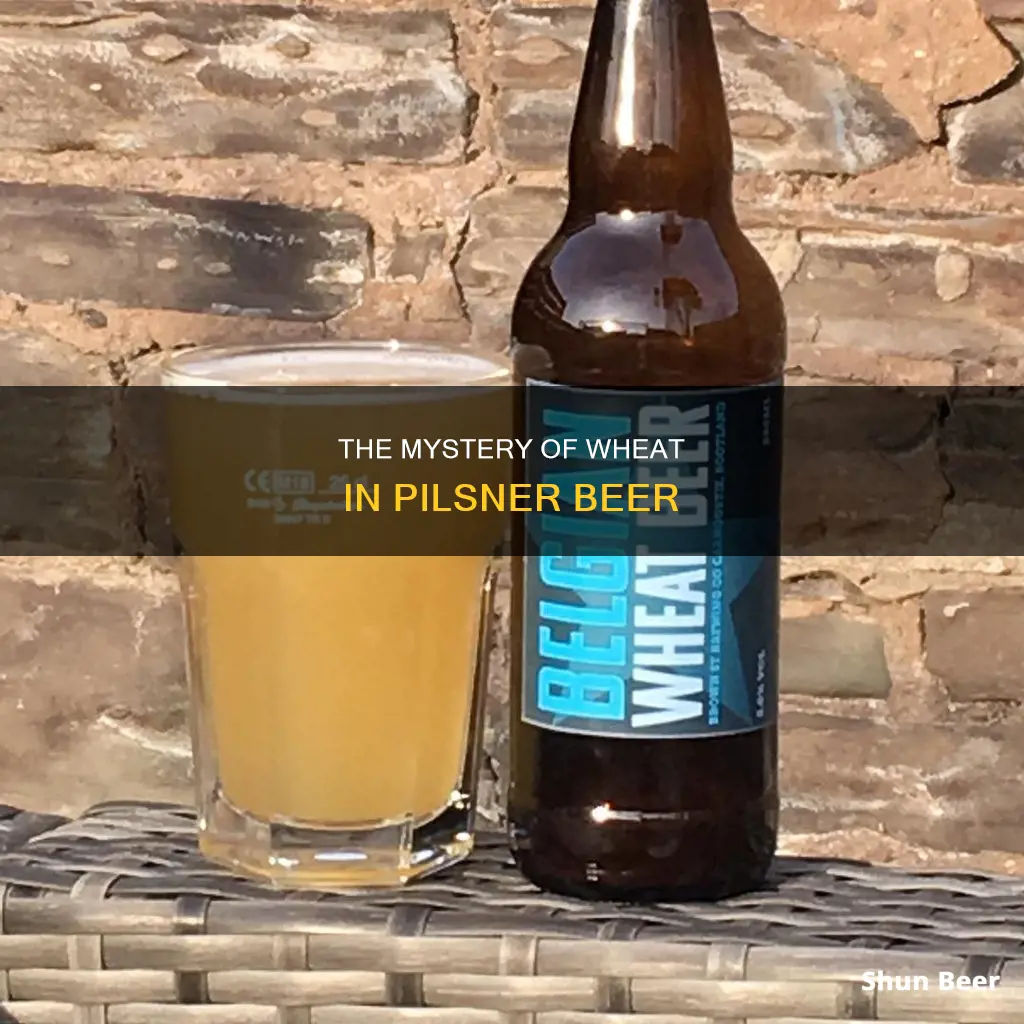
Wheat beers are typically light in colour, low to medium in alcohol content, and can be cloudy or clear in appearance. They are usually top-fermented ales and must contain a high percentage of wheat. On the other hand, lagers are bottom-fermented and can be made with grains other than wheat, such as corn, barley, rice, or any combination of those grains. Pilsner is a type of pale lager that was first brewed in the town of Pilsen (Plzeň) in what is now the Czech Republic. So, is there wheat in pilsner beer?
What You'll Learn

Pilsner is a type of lager
Lagers are a newer style of beer, differentiated from ales by two key factors: the type of yeast used, and the fermentation process. Ales are fermented with top-fermenting yeast at warm temperatures, whereas lagers are fermented with bottom-fermenting yeast at cold temperatures. Lagers also ferment for longer than ales.
Pilsners are a specific style of beer, with a light golden colour, high carbonation, and a distinct hoppy bitterness. The golden colour comes from the pale malts with which they are brewed, while the hops contribute to their unique aroma and bitter taste. Traditional Czech pilsners use Saaz hops, but other varieties may use different hops for varied flavour profiles.
The brewing process for pilsners begins with pale malts mixed with hot water in a procedure known as mashing. This activates enzymes, which convert the grain's starches into fermentable sugars, resulting in a sugary liquid called wort. The wort is then transferred to a kettle and boiled for about an hour, during which hops are introduced. After the boil, the wort is rapidly cooled and moved to fermentation tanks, where bottom-fermenting yeast is added.
Following fermentation, pilsners enter the lagering phase, where the beer is stored in cold conditions for several weeks to months, facilitating its maturation. This period allows flavours to blend seamlessly and any harsh notes to mellow.
While all pilsners are lagers, not all lagers are pilsners. 'Lager' is a broad category of beer that encompasses a variety of styles, from darker ones like dunkels and Baltic porters, to lighter ones like pale lagers, helles, and pilsners. When ordering a lager at a bar, drinkers are usually expecting a pale lager, such as Stella Artois or Heineken. While these beers have a similar appearance to pilsners, they have a different taste profile, with a milder hop presence and a more malt-forward taste.
German Beer: Wheat or Malt?
You may want to see also

Wheat beers are usually top-fermented
Wheat beers are brewed with a large proportion of wheat relative to the amount of malted barley, and typically use at least 30% wheat. The two main varieties are German Weizenbier and Belgian witbier, but other types include Lambic (made with wild yeast), Berliner Weisse (a cloudy, sour beer), and Gose (a salty, sour beer).
The top-fermenting process is also known as "warm fermentation" and typically results in more alcohol and less sugar than bottom fermentation. The yeast used in top fermentation, Saccharomyces Cerevisiae, tends to float to the surface of the wort, giving the process its name. Fermentation time is usually shorter due to the higher temperature, and the warmer temperature also favours the release of the yeast's flavour byproducts, such as fruity esters and bitter tannins.
Wheat beers are typically light in colour, low to medium in alcohol content, and can be cloudy or clear. They are often low in bitterness and easy to drink, with a soft, smooth flavour. The most widely known wheat beer is Hefeweizen, a refreshing German style that is popular around the world.
Wheat to Beer: Brewing Process Explained
You may want to see also

Lagers are bottom-fermented
Wheat beers are usually top-fermented ales and must contain a high percentage of wheat. Lagers, on the other hand, are bottom-fermented. So, what does this mean?
The process of bottom fermentation involves yeast slowly settling down at the bottom of the tank. The yeast particles drift down like snow, starting at the top and ending up packed together at the bottom. Bottom fermentation takes a lot longer—usually well over a month. It is carried out at lower temperatures, between 42 and 55 degrees Fahrenheit.
Bottom fermenting yeast is often called lager yeast, and it is used to make the most common type of beer that uses bottom fermentation. Bottom-fermented lagers tend to be very crisp and clean-tasting.
Lagers are a newer style of beer, with two key differences from ales. Firstly, they ferment for longer at a lower temperature, and secondly, they rely on bottom-fermenting yeasts.
Lagers are a diverse bunch, with a wide range of colours and styles. They include popular pale varieties like pilsners, as well as darker styles such as dunkels. Pilsner is a type of pale lager that takes its name from the Bohemian city of Plzeň (or Pilsen), where the world's first pale lager was produced in 1842.
Paulaner Hefeweizen: A Wheat Beer Delight
You may want to see also

Pilsner uses local ingredients
Pilsner, also known as pilsener or pils, is a type of pale lager that was first brewed in the city of Plzeň (or Pilsen) in Bohemia, now the Czech Republic. The original Pilsner Urquell was created in 1842 by the Pilsner Urquell Brewery, using local ingredients.
The Bavarian brewer Josef Groll was recruited by the Plzeň brewery and used local ingredients to produce the first batch of pale lager. The combination of Plzeň's soft water, local Saaz noble hops from nearby Žatec, low-protein Moravian barley malt, and Bavarian-style lagering resulted in a clear, golden beer.
The soft water used in pilsner brewing is important to the overall taste of the beer. The water in German pilsners tends to have a relatively high sulfate content, which contributes to the bitter taste. In addition, the use of pilsner malt, which has a slight sweetness, accents the bittering and makes the beer more drinkable.
The Moravian barley malt used in the original pilsner was prepared using indirect heated kilning, which gives the beer its distinctive golden colour. This process, along with the other local ingredients, contributed to the unique flavour and character of the first pilsner.
Cider Beer and Wheat: What's the Connection?
You may want to see also

Wheat beers are light and refreshing
Wheat beer is brewed using a mixture of malted wheat and barley, hops, water, and yeast. The wheat malt used in the brewing process gives wheat beer its unique taste and aroma. The fruity taste comes from the yeast used in the brewing process, which produces esters that give wheat beer a banana or clove-like flavour. The spicy flavour comes from the addition of hops, which adds a slight bitterness that balances the sweetness of the malt.
Wheat beer is known by a few different names, especially in Germany and the surrounding region where it originated:
- Weissbier: Bavaria and Austria
- Weizenbier or Weizen: Northern and Western German regions
- Bière Blanche: France
There are several types of wheat beer, each with its own unique taste and flavour profile. Some of the most common types include:
- Hefeweizen: A German-style wheat beer that is unfiltered and brewed using a high percentage of wheat malt. It has a fruity and spicy flavour with a banana or clove-like aroma.
- Witbier: A Belgian-style wheat beer brewed using a mixture of wheat and barley malt. It has a light and refreshing taste with a citrusy flavour and aroma.
- Berliner Weisse: A sour wheat beer that originated in Berlin, Germany. It has a tart and acidic taste with a light and effervescent body.
- American Wheat Beer: A modern take on traditional wheat beer that is brewed using American hops and a higher percentage of barley malt. It has a crisp and refreshing taste with a citrusy and floral flavour.
Exploring Bock and Wheat Beer Differences
You may want to see also
Frequently asked questions
No, pilsner is a type of lager, which is typically made with barley, corn, rice, or sorghum. Wheat beers, on the other hand, must contain a high percentage of wheat.
Pilsner is a pale lager with a crisp, refreshing taste. It is made with pilsner malt, lager yeast, lightly kilned malted barley, hops, and soft water.
Pilsner has a dry, slightly bitter flavor and a clean, simple taste. It is known for its dense white head and straw-colored body.
All pilsners are lagers, but not all lagers are pilsners. The key difference is that pilsner is a specific style of beer within the lager family, characterised by its signature look and taste.
Pilsner is the most popular style of beer worldwide and is brewed all over the world. You can find it in most parts of the world, including the United States, Germany, the Czech Republic, and beyond.







